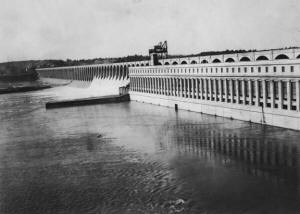
Towering in size, incomparable in scale and ambitious in design, the Wilson Dam project, constructed from 1918-1927, established a standard for the nation for future waterways improvement. The largest mass concrete United States lock & dam yet built, it was the first federal hydroelectric project as well as the first Corps of Engineers multipurpose effort. Congress, noting the combined benefits of flood control, aid to commercial navigation and the production of hydroelectric power in a single project, soon mandated these elements be evaluated in all new investigations. In 1933, the completed project amazed and inspired newly elected President Franklin Roosevelt to create the Tennessee Valley Authority. This act revitalized a region and provided a blueprint for development of water resources nationwide.
Wilson Dam marked the first successful attempt to tap the potential of the Tennessee River. Efforts to develop the river for economic purposes dated back to the 1830's. Inadequate, they failed to achieve significant results. The barrier of the Muscle Shoals continued to divide the residents of the Tennessee Valley geographically and socially. Poverty stricken, the region led the nation in grim categories like illiteracy, lowest per capita income, infant mortality and the availability of electricity and running water. Initially authorized for national defense, the completion of Wilson Dam paved the way for a period of development that harnessed the river. Rapid industrialization and economic diversification swept the valley.
Based on a survey report submitted by Nashville District Engineer, Major Harry Burgess, the Wilson Dam was the most ambitious American public works project of the period. The massive structure, 137 feet in height and more than 4,500 feet long [world record] required the excavation of nearly 1.5 million cubic yards of earth and rock and consumed 1.3 million cubic yards of concrete. At 94 feet, its lock lift established another world record and remains the highest on the system. At peak construction, more than 4,000 men labored at the site, requiring the construction of a small town to house them and their dependents. After 75 years Wilson, at 630,000 KW is still among the highest capacity hydroelectric plants in the nation. At a total cost of nearly $47 million, it truly was an extraordinary project for its time.
Simultaneous with Wilson's construction, Nashville District conducted a comprehensive survey of the economic potential and future improvement of the Tennessee River. The final report, advocating power-navigation dams on the main stem and power storage dams on the tributaries, became the foundation of multipurpose development in the valley. When created in 1933, the Tennessee Valley Authority, using Wilson as a model, implemented these advance plans.
The construction of six multipurpose dams and the pressing of other initiatives gradually awakened the region from its torpor. Flood damages fell, barge traffic, barely a million tons a year in 1930, surged and the availability of affordable electric power transformed everyday life in the valley. In 1933, Muscle Shoals became the first community to receive electric power via the facilities at Wilson Dam; within a few years, more than one hundred other municipalities would join it. This new development, as one economist noted, gave the residents "universally high standards of living, new jobs, leisure, freedom and an end to drudgery, congestion, noise, smoke and filth." Much of this remarkable transformation has its roots in the Wilson Dam, the pathfinder federal multipurpose project that unlocked the potential of a dynamic, but isolated region.